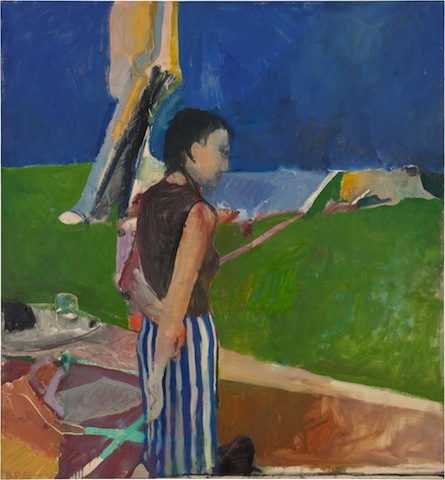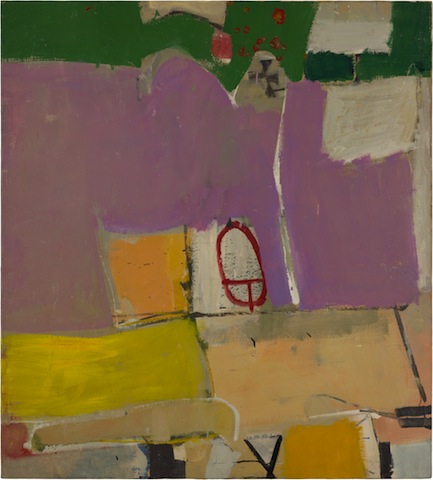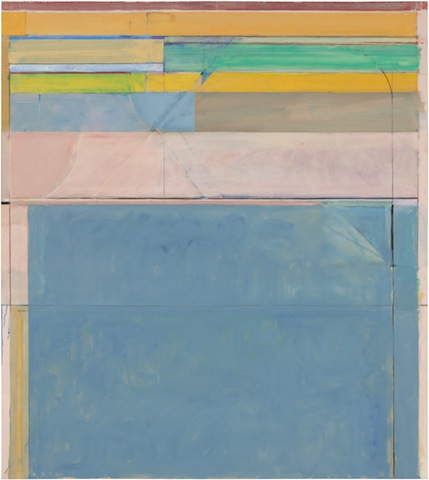Made an Honorary Royal Academician just a few months before he died, in 1993, it’s taken till now for a posthumous Royal Academy survey to finally bring one of the absolute greats of American postwar painting to a UK audience. Of course, for those with long memories, there was the Whitechapel Gallery exhibition of 1991, but though it provided the impetus for the belated honour, it seemed to do little to bring the paintings of Richard Diebenkorn into the public realm.
Diebenkorn, who spent most of his life in California, finally settling in Santa Monica in the mid-Sixties where he began his epic series of Ocean Park paintings, came of age as a younger contemporary of the Abstract Expressionists. Born in 1922, he was just 12 years younger than Jackson Pollock, and 18 years the junior of Willem de Kooning, whose paintings Diebenkorn’s early abstract works most resemble.
For the most part, however, this very American artist, whose paintings are often suffused with the light and variegated colours of particular landscapes, found kinship with the European modernists. Matisse stands as the artist who most directly got under the skin of his work, and indeed there have been few artists who have engaged as deeply and as intelligently with Matisse’s paintings, and yet managed to create a distinctly American panorama, both in his figurative work and, to a point, his later abstract canvases. We see this in Diebenkorn’s use of the open window motif, in the often striking similarities of composition and structure, and in his instinct for uplifting colour harmonies. And there’s always that exquisite sense of tension and balance in Diebenkorn’s paintings. (Pictured below right: Girl on a Terrace, 1956; Neuberger Museum of Art, New York.)
 So why, in the UK, has Diebenkorn spent decades off the radar? No public collection here owns a painting by him. One easy answer might be that he simply doesn’t fit into any isms – by the time Pop Art and Minimalism were busy eradicating the expressive hand of the artist, Diebenkorn was pursuing that which wasn’t being pursued in the epicentre of the art world, namely New York. And he was doing it with the kind of deeply seductive, gutsy painterliness that, say, Philip Guston, that other abstract-turned-figurative painter – and upstate New Yorker – wasn’t. Unlike Guston, Diebenkorn retained an old school (for that read European) modernist sensibility.
So why, in the UK, has Diebenkorn spent decades off the radar? No public collection here owns a painting by him. One easy answer might be that he simply doesn’t fit into any isms – by the time Pop Art and Minimalism were busy eradicating the expressive hand of the artist, Diebenkorn was pursuing that which wasn’t being pursued in the epicentre of the art world, namely New York. And he was doing it with the kind of deeply seductive, gutsy painterliness that, say, Philip Guston, that other abstract-turned-figurative painter – and upstate New Yorker – wasn’t. Unlike Guston, Diebenkorn retained an old school (for that read European) modernist sensibility.
Anyway, that’s one answer. Let it not detain us here. In the beautiful hang of the Royal Academy’s Sackler Galleries we’re offered a crisp, chronological survey in three discrete segments. It follows the distinct phases of Diebenkorn’s entire output, but it’s far too small to call it anything like a comprehensive overview. What it is is a judiciously edited one which manages to cover four decades coherently and succinctly. And while the exhibition may be relatively small, especially given Diebenkorn’s prodigious output, it is undeniably huge in impact: there’s a wow-factor as soon as you enter the first gallery, and those wows, as they say, just keep coming. But these paintings aren’t, of course, just instant pleasers – Diebenkorn is bold and big-gestured as a painter, but these are also paintings that are layered, textured, subtle, nuanced, complex. Like any truly great painter, there’s the slow-burn factor, too.
The first room is given to the years 1950 to ’53, when Diebenkorn, who grew up in San Francisco, was based in Albuquerque, New Mexico, where he studied art, then in Urbana, Illinois, where he taught architecture students to draw, and after that in the Bay area of Berkeley. A couple of the early abstract Berkeley paintings feature here, these leading to the second gallery where we see Diebenkorn abandon abstract painting and become part of the Bay Area Figurative Movement. Diebenkorn’s paintings, whether landscape or abstract, nearly all refer to place in their titles, so the headings for the gallery wall panels follow suit, tying the artist firmly to geographical location.
 The rich ochre palette of his Albuquerque paintings, lifted by coppery reds or pale, minty greens or dusty pinks, are deeply suggestive of the colours of that rocky, mountainous region, though there’s nothing to actually suggest these are landscapes (pictured left: Albuquerque #6, 1951; Saint Louis Art Museum). These are really “all-over” paintings in the manner of the Abstract Expressionists, while the Urbana works have the density and brooding mass of de Kooning paintings, such as we see in Urbana #6, with its blocky, interlocking shapes, but without the older artist’s slippery, frenetic gestures. Meanwhile, the verdant greens and blues of the Berkeley abstracts, with passages of fleshy pinks, dirty yellows and maroons with dark blue underpaintings, are the colours which also dominate in the Berkeley figurative paintings – and you can almost feel the heat of the sun in those.
The rich ochre palette of his Albuquerque paintings, lifted by coppery reds or pale, minty greens or dusty pinks, are deeply suggestive of the colours of that rocky, mountainous region, though there’s nothing to actually suggest these are landscapes (pictured left: Albuquerque #6, 1951; Saint Louis Art Museum). These are really “all-over” paintings in the manner of the Abstract Expressionists, while the Urbana works have the density and brooding mass of de Kooning paintings, such as we see in Urbana #6, with its blocky, interlocking shapes, but without the older artist’s slippery, frenetic gestures. Meanwhile, the verdant greens and blues of the Berkeley abstracts, with passages of fleshy pinks, dirty yellows and maroons with dark blue underpaintings, are the colours which also dominate in the Berkeley figurative paintings – and you can almost feel the heat of the sun in those.
Often you’re reminded of topographical paintings, possibly influenced by Diebenkorn’s wartime military training. Cityscape #3, 1963 (main picture), is a bird’s eye view of a landscape tilting forward, all blocky, solid geometry – and here you think of Cézanne. Elsewhere are the quiet still-lifes that conjure Manet and pay homage to the well-made object, economical, utterly seductive: a pair of scissors with the blades open; a knife in a glass of water; or a delicate glass containing a simple bouquet being arranged by a pair of disembodied hands. Human figures are as still and solid as the furniture.
 The final gallery takes us to the monumental Ocean Park series, or rather, five paintings from that series, which, beginning in 1967 and ending in 1988, became the artist’s most sustained body of work, producing at least 145 paintings and 500 related works on paper. These luminous abstract paintings, in colours one might be tempted to describe as pretty, remind me of bits of joinery painted in the pastel colours of a beach hut. (Pictured right: Ocean Park, #116; 1979; Fine Arts Museums of San Francisco.) One thinks of the sea, the sun, the weathered architecture of those places. They are glorious, but I don’t think of them as the apotheosis of Diebenkorn’s career, as many have argued they are, for each phase of it produced its own astonishing treasures. The contemplative quietude of the representational works are just as richly rewarding. Wow, indeed.
The final gallery takes us to the monumental Ocean Park series, or rather, five paintings from that series, which, beginning in 1967 and ending in 1988, became the artist’s most sustained body of work, producing at least 145 paintings and 500 related works on paper. These luminous abstract paintings, in colours one might be tempted to describe as pretty, remind me of bits of joinery painted in the pastel colours of a beach hut. (Pictured right: Ocean Park, #116; 1979; Fine Arts Museums of San Francisco.) One thinks of the sea, the sun, the weathered architecture of those places. They are glorious, but I don’t think of them as the apotheosis of Diebenkorn’s career, as many have argued they are, for each phase of it produced its own astonishing treasures. The contemplative quietude of the representational works are just as richly rewarding. Wow, indeed.








![SEX MONEY RACE RELIGION [2016] by Gilbert and George. Installation shot of Gilbert & George 21ST CENTURY PICTURES Hayward Gallery](/sites/default/files/styles/thumbnail_125_x_125_/public/mastimages/Gilbert%20%26%20George_%2021ST%20CENTURY%20PICTURES.%20SEX%20MONEY%20RACE%20RELIGION%20%5B2016%5D.%20Photo_%20Mark%20Blower.%20Courtesy%20of%20the%20Gilbert%20%26%20George%20and%20the%20Hayward%20Gallery._0.jpg?itok=3oW-Y84i)





Add comment